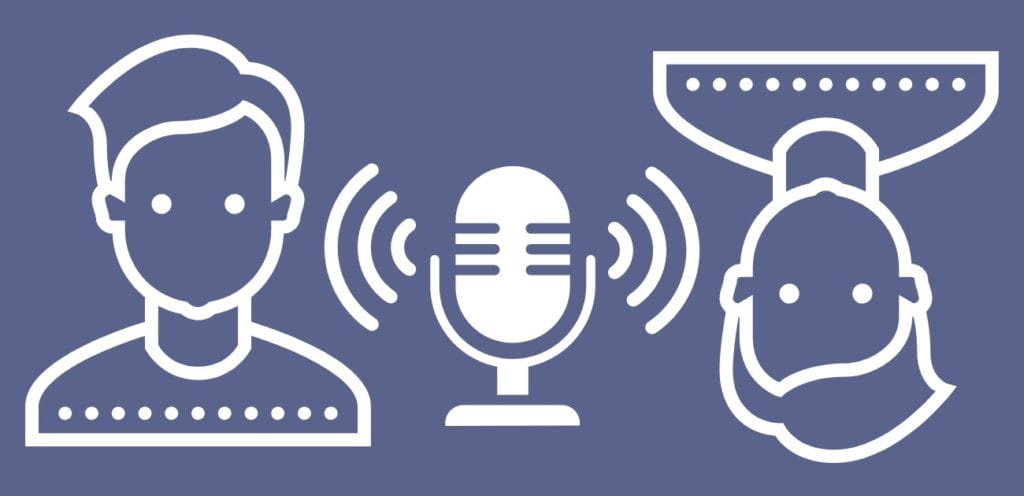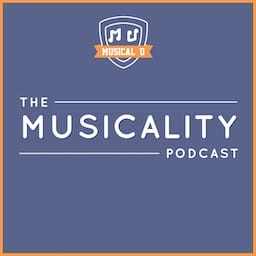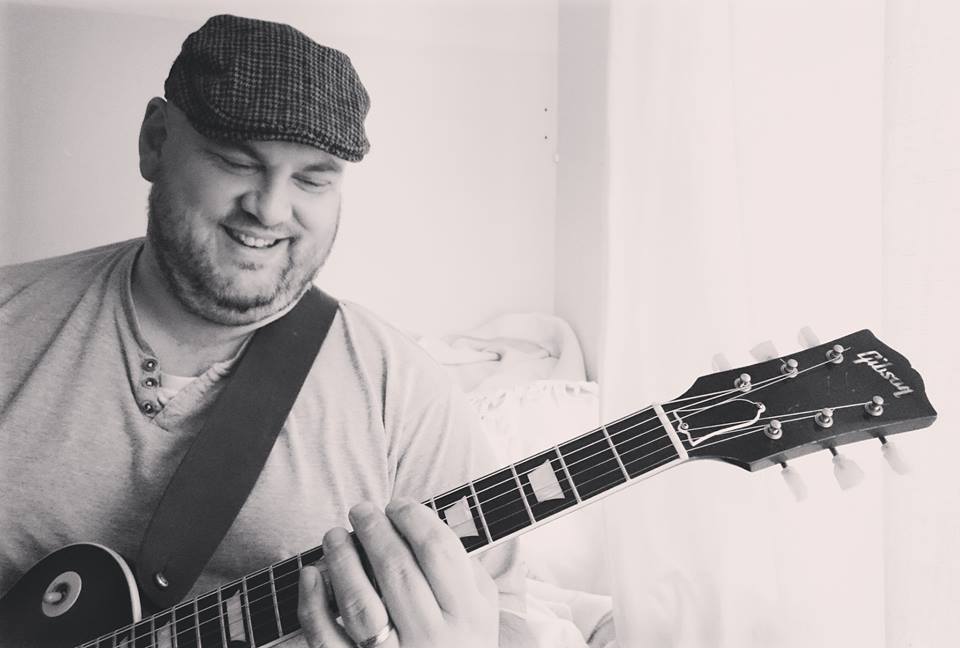Recently on the show we did an episode on something called the Lydian Chromatic Concept of Tonal Organization (LCCOTO) with Andrew Bishko from our team. Andrew introduced me to this when he wrote a tutorial about the Lydian scale for our website, and in the process of putting that article together we came across a man called Andy Wasserman, one of just a handful of people in the world who is fully trained and certified to teach the Lydian Chromatic Concept.
So we were really keen to invite Andy onto the show to share a bit more about this – but as you’ll be hearing, Andy is actually a highly remarkable musician, composer and educator and we could have easily done a whole series of interviews with him!
Andy is a professional pianist, composer, arranger, performer and producer, in genres as diverse as Jazz, World Music (meaning West African, Asian, Middle East, Native American, Latin & Afro-Cuban, South American), Fusion, Funk, Hip-Hop, Electronica, Blues, New Age, and Gospel. You will have heard his music on TV and radio. And he’s had a fascinating journey to become the musician he is today.
We tried to reign ourselves in and focus on just a few topics, so in this conversation you’ll be hearing about:
- The four music mentors that helped Andy become the musician he is today, and the specific impact each had
- Andy’s view on talent and what we can learn from paying attention to the music that resonates with us
- And of course the Lydian Chromatic Concept created by his mentor George Russell, renowned composer and recipient of the MacArthur Foundation “Genius” Grant. It’s a framework for understanding music, which Andy has spent decades helping to develop and teach.
It’s a bit of a mouthful of a name, but as you’ll hear the Lydian Chromatic Concept is, in a way, quite simple – in the sense of being fundamental and universal. It’s not something we could ask Andy to actually teach in a podcast episode like this but we talk in depth about what the Concept is, the way it can transform how you hear and play music, and how to go about learning more about it if you want to experience that transformation for yourself.
Listen to the episode:
Links and Resources
Enjoying The Musicality Podcast? Please support the show by rating and reviewing it!
Rate and Review!
Transcript
Christopher: Welcome to the show, Andy. Thank you for joining us today.
Andy: Thank you for the honor and the privilege to be with you.
Christopher: You play a huge range of instruments and styles of of music, perhaps more than any other musician I know. I think I saw a video online of you sharing your collection of musical instruments. How many would you say you own or play at this point?
Andy: Well, the last time I counted, and this is including a lot of hand percussion, so I am counting each and every finger cymbal and tambourine and flute and whistle, including some huge, beautiful instruments like the Japanese koto and a wide selection of beautiful drums that I’m privileged to have. The number right now is over 140.
Christopher: Goodness me, and you can play all of these, presumably?
Andy: To certain degrees I have studied and learned about the culture that they’re connected to. For our listeners who haven’t visited my website in terms of my arts and education program, The World Music Experience, these are wind, string, and percussion instruments that represent not every culture of course but the cultures that I have gravitated to over the years and so it’s learning about the instrument, the materials, how to play them from people from other cultures as well as how to maintain them, how to play authentic music and not just jam on them and that’s taken me over 40 years so it’s been a lifelong process that actually started and was inspired by growing up in an extremely diverse and multicultural community in Manhattan where people from all around the world would open up their arms and their homes and even help me get the instruments without having to travel in order to bridge the gap between western music and non-western music.
Christopher: Well, it certainly comes across in your music publishing, your catalog of works. I think there are over 100 releases to your name and they span such a variety of musical styles. It’s clear you have explored in all directions and I’d love to know if you think back maybe to that time in Manhattan or even earlier, was it always obvious to people around you that you were going to grow up to be this incredible musician with an amazing library of musical works and the ability to play some of the instruments. Was that obvious when you were a child, do you think?
Andy: I don’t know about anyone else but to myself the answer is yes. When I was very young I was privileged to grow up in a home where my grandfather had bought my grandmother a beautiful grand piano so the resonance of a full-sized, you know, beautiful instrument was right there at my fingertips and I heard a sound I have come now to learn a lot more about them. In fact I set out in my life even as a chid to find out, what is this sound that I hear?
It’s not like a sound I heard in my head, you might say but it was a feeling, it was what I now call a resonance and as a little child I used to reach up to the keys before I could even be big enough to sit at the piano and I would press the keys and feel connected to some type of mysterious language that I was communicating to something that was invisible, because, let’s face it, sound is technically invisible. It’s something that we can’t see or taste but we can hear it and these vibrations moved me and at a very early age I started to realize that it’s the music in us that hears the music so I was immediately drawn towards the inner life of, “What is this music that’s already in me?” and for our listeners I would encourage you to be open to this idea because it’s not necessarily discussed all of the time but if you think about it the music that we love, the music that we’ve always listened to, the reason we’ve chosen instruments because we love their sound like a violinist who says, “I just had to play the violin because I love the sound of the violin,” it’s because, I like to phrase it, it’s the music in us that hears that music so I immediately went searching for that which I sometimes refer to as the universal sound and then upon learning about rhythm I realized that we’re all on this beautiful treasure hunt and we’re looking for what the pirates used to call the treasure chest. I like to say it’s the treasure in our chest which is the drum that’s beating all the time so the feeling of my heart beat, the rhythm of the body, the rhythm in life, that sound of the music in us. I realized I have talent on loan to me and I’m going to devote the rest of my life towards paying back everything I can to work as hard as I can to develop this talent that is on loan to me and then my life just unfolded with everything that you describe.
Christopher: Amazing. I’d like to dwell on this for just a moment if we may because talent is a topic that comes up quite a lot on this podcast and we find that a lot of people, both the very established and successful and capable musicians and those who are doing it purely as a hobby and maybe don’t think all that much of their musical abilities, tend to view that word with a bit of skepticism just because it often does more harm than good, the idea that, you know, you need talent or you can only do what your talent allows you to and I’d love to hear your perspective because you mentioned a couple of things there that you felt you had been blessed with a talent that you had this ability that you would spend your life trying to cultivate and maximize but you also talked in terms of us all having music inside us and all having that ability to connect with, as you put it, the universal sound so how do you think about this topc of talent?
Andy: Well, that’s a great question, Christopher, and I do have a very strong feeling. It can’t be proven by science and some people may be skeptical because we’re all filled was self-doubt. Part of that propels us to work very hard, you know, to strive to become better at our musical skills but I believe, and I’ve been teaching now for over 35 years, that every single person is already a musical master. They just don’t know it and so I’m keen on mentoring because I have had, I tell people when they say, “What’s your claim to fame?” I say, “My claim to fame is that I have had the great, great, humbling opportunity to have had not one, two, three but four very powerful mentors in my life and I say a mentor more than an instructor as an instructor can tell you what to do but a mentor tells you what to be, who to be, who you are and that’s where the talent lies, not necessarily in what to do, because that’s more of a skill that can be practiced and worked on and frankly we run into limitations based on our physicality of the instrument and our hands or our voice, etcetera but those can be overcome. But the question of what to be and who you are, my mentors showed me that I am already a musical master, I just don’t know it and I’d like to give, if you don’t mind, a short analogy which I think people can relate to which is one of my favorite ones when my students look at me and go, “You’ve got to me kidding. I’m already a musical master and I — you’re right. I don’t know it and I don’t think it’s possible,” and I like to use the analogy of an acorn and an oak tree and that is that as a little baby acorn I find my mentor that’s like a towering, beautiful oak tree that offers shade to us striving musicians out on the path and they’re looking at this acorn and they know that everything that is an oak tree is already completely, fully formed within that acorn.
The only thing is the acorn has to go through a period of transformation to obliterate its acornness. It can’t identify and stay on the acorn level, which I would say that’s people who say, “Well I don’t have the talent,” that’s because they’re only looking at their acorn-hood, so to speak, but when a mentor can say, “You are an oak tree and nobody can deny that within an acorn is an oak tree. All it has to do is fall beneath the ground and grown roots and then a little stalk and that stalk can turn into a huge tree trunk with branches and guess what? End up giving birth to thousands of other acorns over time.”
So if people would look at themselves as already having the potentiality, as another way of saying, it for all the ultimate talent that is on loan to all of us, I mean, especially with Youtube and the internet I think, to quote the great jazz trumpeter Dizzy Gillespie, it’s obvious that no one has a monopoly on talent. There is so much musical talent everywhere and I’d like to encourage all of our listeners and all the members at Musical U that you are all masters of music and through finding a mentor and the other processes that your website offers at your school that maybe people can find out how to go from an acorn into the oak tree that’s already within them.
Christopher: Wonderful. I love that analogy. I think that’s a beautiful way of looking at it and I think it very neatly helps people reconcile the idea of the talent they admire and they’re inspired by and maybe a little intimidated by, with the idea that they could have just as much talent brewing inside themselves, just waiting to be unleashed.
If it’s not too simplistic, I’m sure we can’t boil a lifetime down to a short segment of a podcast but I’d love to hear, if you wouldn’t mind, a little bit about those four mentors and maybe the transformation each of them helped you through in terms of who you were before and after working with them.
Andy: Well, thank you so much for asking that because these people deserve not to be forgotten. They were, and none of them are currently alive anymore, but they were some of the greatest musicians and innovators and teachers. I sought them out instead of looking to have some type of brilliant career for myself. I thought, “If I can find and be accepted by some of the greatest musicians on the planet and those oak trees will nurture and nourish my acorn-hood to transform into hopefully something like them. That would be the greatest thing that I could do.”
So I was lucky growing up in Manhattan. There was a school called The Metropolitan Music School near Central Park and I’d like to say, because I noticed on your website that you encourage a tremendous amount of ear training and listening skills. In order to sign up for lessons with my first mentor, her name was Ann Bacon Dodge, and for those people that know some very wonderful books that were written in the early part of the 20th century by my teacher’s husband, Roger Pryor Dodge, my teacher was named Anne Bacon Dodge and Roger Pryor Dodge was a historian, a jazz historian so she knew an awful lot about that but in order to sign up for lessons with her they made me go every Saturday for three hours and do music dictation and ear training. Of course this is prior to computers so everything was done with an instructor and I had to study ear training, listening skills and music theory just in order to take private lessons and that was extremely helpful. So she created the foundation and taught me about the blues, about playing Bach two-part inventions and set a foundation for me as a pianist, that’s my favorite instrument and my lifelong main work because it takes all of that and the next great opportunity I had was Dwike Mitchell, that’s D-W-I-K-E, an unusual first name.
Actually the longest running jazz ensemble, which was a duo in the history of jazz was Dwike Mitchell and has partner in musicality, Willie Ruff, who is actually pretty famous because he’s been a professor at Yale for most of his life teaching jazz and they toured the world as the Mitchell-Ruff Duo where Dwike played the piano and Willie Ruff would switch between bass and French horn.
Dwike Mitchell and I had a relationship that lasted 30 years and he’s the one that really allowed me to understand everything orchestrally that can be expressed on piano and I will say that it’s very difficult to learn about music without learning about yourself and you start seeing things in your own character, your personality, hang-ups or things that have affected you in your life emotionally in any kind of negative way. Those really have to be removed in order to feel free, especially in jazz, to feel free enough to express the joy and the sadness and everything as you improvise and create new music every day so he also helped me as a young person to grow and to learn about myself and help me overcome things that I needed to do as I grew into a more mature adult.
That was followed by him saying oneday, he used to call me his son, his musical child. He said, “Son, you have to go to school now, not just lessons with me,” so I sought out George Russell, the innovative band leader, composer and creator of the Lydian Chromatic Concept of Tonal Organization and luckily was accepted full-time as a student, undergraduate level at the New England Conservatory of Music and I ended up becoming so close to George that he certified me as a teacher. I would take over his classes when he’d go on tour. I would help him with his seminars and then worked for 20 years amongst the staff of other dedicated people and students of his as an editorial assistant for the current edition of his treatise, “The Lydian Chromatic Concept of Tonal Organization, the Art and Science of Tonal Gravity.” There is no way to even begin to tell you how he affected my life on every level, especially opening up my ears to sounds and the language of music, which now I refer to as relating to the hypothesis called linguistic relativity which basically says that new languages that you learn or the inherent language that you grow up speaking has a definitive effect in your consciousness, how you view the universe, how you relate to your life and so when you learn a new language like the Lydian Chromatic Concept it actually alters your entire perspective through linguistic relativity to everything that you perceive and, again, this was a lot of internal growth, that music that’s inside of you and then finally I realized that the heart and the heart of most, what we now call World or World Beat music is rhythmically based, but there is also a code, I call it the timekeeper’s code where the beats themselves speak and it’s a living language of rhythm and through amazing amount of luck I became very close to Papa Ladji Camara who is considered to be in the history books the very first west-African drummer in the 1940’s and 50’s to take the djembe drum that everybody now all around the world is familiar with the djembe, the most popular west-African drum. He was the first one credited to taking it around the world when he toured with Les Ballets Africains de Keita Fodéba and so Papa Ladji was already an aged person but still teaching and I ended up working with him and living with him and he’s the one that taught me the roots of west-African drumming and when you put all of those things together it’s inspiration that to this day fuels every note that I play, everything I feel about music in my heart and for sure propels my dedication to wanting to pass it on to my students and anyone that I can possibly help.
Christopher: Wow, thank you. I’ll admit when I was preparing for this interview I was simultaneously super-excited and a little bit overwhelmed because you have had an incredible journey so far and I feel like we could do at least an hour-long podcast episode on each of those phases of your musical development and really dig into what you learned and how it worked and I would love to spend a day with you and so I had to challenge myself to try and narrow it down a little because we could explore in so many interesting directions and one thing you touched on there jumped out, which is the Lydian Chromatic Concept and we recently did a couple of podcast episodes which touched on this one with a member of our team, Andrew Bishko, and then a follow-up episode providing a very brief introduction and as we said at the time, this was really just scratching the surface of what is a very substantial and fascinating thing but we’ve already received some feedback suggesting that this was one of the most interesting and mind-blowing episodes we’ve done on the podcasts so far and so I felt like that was perhaps the most important thing to touch on in today’s episode with you and really draw from your amazing experience so if you wouldn’t mind I’d love if we could talk a little bit about the Lydian Chromatic Concept which, as you say, you learned from George Russell, its originator.
Andy: Well, thank you so much and I would like the members of Musical U and whoever is tuning in to this podcast to know that it speaks volumes about the integrity of your organization, Christopher, that you will allow this beautiful knowledge to be shared and be open, you know, to adding this to the other elements of music theory that you’re trying to share to enhance your members’ and listeners’ skill. So thank you so much for being open to the Lydian Chromatic Concept. I just want you to know that I appreciate that and I know that if George was alive today, he passed away at age 86 in 2009 so he’s not here but he would also thank you for recognizing that there is great value, especially for musicians today.
What I would like to allow people to feel a little more comfortable about the the concept and rest assured about something that is usually not brought out because people see it immediately as something that might be so different and perhaps diametrically opposed to traditional western music theory and through my own personal experience I can 100% guarantee that what I’m about to tell you is the truth because I saw George Russell sitting at a desk laboring for decades to have his system of music be very inclusiive of already existing western music and even bend the rules a little bit so that people coming to the Lydian Chromatic Concept with already existing knowledge from traditional western music theory lessons and all of the ramifications of melody, harmony, texture, rhythm and specifically, of course, most people know that jazz improvisers including Miles Davis and John Coltrane changed the direction of jazz in towards the modal period as it’s known and illustrated by the album, “Kind of Blue,” having being turned on to in the camaraderie of their circle of incredible culture, mostly in New York in the 1950’s and early 60’s through George Russell and the Lydian Chromatic Concept and the improvisers since then that have come to George, he was very well aware that we can’t say, “Forget everything you learned,” or “It’s irrelevant,” or the worst thing to say, which is the opportunity of what the concept says, which is “This is bad or wrong,” so the first thing that I would like to illumiate for people because it also might be new is that George did, first of all, was stand back and say, “What is the music itself telling us about its own self-organized unity?” and when he posed that question, which is an extremely deep question and shows you what an amazing human being he was, he realized that just like physics and physicists who study the physical universe, most everyone agrees, especially those people that have learned from Albert Einstein, that gravity is a force that we are all subject to just like the fact that you and I are now conducting an interview not like Mary Poppins where we’re floating to the ceiling, having tea but we’re actually sitting on the ground and gravity is pulling us toward the center of the earth.
So once George realized that music is physics, it’s like waves, it’s particles, it’s vibrations, that gravity had to be recognized as perhaps, and he ended up proving it to a great degree, the prime moving force of how music itself, not what we do with it, but how music itself is expressing itself, its actions.
So he calls it tonal gravity and when one looks at the existence of tonal gravity immediately there is a verticality straight up and down like if you have a circle with a map, north, south axis and once you have that there automatically is a horizontal axis that would be a line going from east to west.
Now, western music theory in conjunction and relativity to the verticality of the Lydian scale, which I know your other podcasts have already described why they’re like a ladder of fifths and that’s what makes them vertical with having one single do, that is a perfect explanation for chord-scale unity that allows people to understand the origin of every chord in a parent scale but that horizontal axis is just as important and that is the resolving tendency in the nature of the major scale which most people define as a structure of two tetrachords, like in the key of C. C, D, E, F is called a tetrachord, whole step, whole step, half, and then you go up a whole step to G and then you have a second tetrachord, G, A, B, C and that’s one of the reasons that ou feel the sense of two do’s and a sense of resolution. It’s perfect for that and the reason that those as a cross in the center of a circle, the reason that those are so perfect in describing all of music so you have the Lydian Chromatic Concept’s attention to verticality mixed with western music’s perfection of resolution evidenced by the major scale and the Lydian scale, it mirrors life because when we’re in the now, when we’re not trying to achieve anything or we’re not goal-oriented in life we’re actually in a vertical state of consciousness and when we have to go anywhere or do anything or create a task we’re in a part of our daily lives constantly in a state of goal orientation and the tension and the release of the goal orientation and then the relaxation and unity of being in the now is music showing us that it’s actually a mirror of life and so the first thing that I want to, you know, summarize based on what I just said is for all you listeners, please know that the Lydian Chromatic Concept is completely open and shows how beautifully traditional western music theory fits within the discovery of tonal gravity and the verticality and the chord scale alliance that is shown so beautifully by George Russell’s concept.
Christopher: Fantastic. I’m so glad you started with that because I know a lot of our listeners’ heads are exploding right now with some of the concepts you introduced there so I think in a moment we’ll break some of that down a little more but you mentioned earlier, you know the prevalence of teaching material online. We live in an age of Google and Youtube and I’m sure some of our listeners have had this experience where you’re looking around online for interesting music things and you stumble across someone who says they’ve got the secret to music and how it works and they’ve invented their own music theory and, you know, in some cases they’ve just taken a subset of music theory and put their own labels on it, their own names, and declared it to be new and in fact it’s just new names on old things and in other cases they’ve discovered some way of explaining things that worked for a very small subset of music but actually when you look at it you realize, no, it’s quite focused and isolated and doesn’t really generalize.
I think, you know, it would be easy if someone has stumbled across a mention of the Lydian Chromatic Concept online for them to be a bit skeptical because it does make some bold claims about its universal application and how powerful it can be and I think, you know as we’ve touched on, it obviously comes from an incredible pedigree from George Russell himself and I think anyone listening to you just describe it will understand that this is not a strange and kind of flimsy alternative to music theory, this is genuinely something that has been very carefully developed and worked on and thought through and, as you put it, compliments and extends what we think of as traditional music theory and it’s not reinventing the wheel, as it were.
Andy: Yes. Well George himself described the Lydian Chromatic Concept as being radical in the sense that once he saw that there was a center of tonal gravity and the possibility of a unified tonal gravity field, which, I hope this isn’t a stretch because most people feel comfortable with multiplying 12 times 12 but maybe not thought about the fact that every key of which an equal temper tuning which is what the Lydian Chromatic Concept is working within. It does not work with scale systems from other parts of the world or earlier in history. It is based on the overtone of the fifth and our tuning system of being able to play any song in any key has to do with, you know, the equal temper tuning so we are limiting it to that but that in equal temper tuning we have 12 notes that can all act as a do, like you play a song in the key of C or G flat or D flat, etcetera and you have 12 possible tones which are also those same 12 tones, not a totally different subset of reordering them for the so-called 12-tone chromatic scale. So if you multiply 12 times 12 you actually realize that there is a limit, as incredible as it might seem to try to master it of 144 possible intervals of, and here’s the key word, close-to-distant relationship to the center.
Now, why is that a little bit different and hard for people to wrap their minds around relative to western music theory? Because in western music theory we think, number one, of and taught through the history of theory itself consonant and dissonant and George was saying if we ask what the music itself is telling us we have to try to be more objective because that viewpoint is quite objective a viewpoint and consonant and dissonant tends to be a little bit more subjective. What one person hears as consonant another person may hear as dissonant and for sure there’s dissonant music that people love to listen to that other people say, “I got a headache within the first ten seconds,” so George says that instead of saying what’s right or wrong, consonant or dissonant, we have close-to-distant relationship where we have ingoing, semi-ingoing, semi-outgoing and outgoing levels of tonal gravity and what he says is that he’s created this map that doesn’t tell you where to go but it shows you all of the possible places so that, getting back to what we said earlier is, it’s critical for every musician, no matter whether they’re a hobbyist or they’re just learning or they’ve been playing forever, to go inside themselves and say, “Why do I play music? What does music mean to me? What is my sound? What is the music in me?” all of those type of esoteric, inner questions and then realize that you could look at a map, for example, I’m comfortable with the United States where I live and some people would say if you want to go from New York City to San Fransisco from the east coast to the west coast there’s an interstate called Route 80 that goes all across the country.
Well, if that’s the way you want to get there, go, but what happens if you have a relative in Atlanta, Georgia and then you want to go to the Glacier National Park in Montana and then you want to go, actually, back in the opposite direction because you want to hear some blues in Chicago and you have this meandering way to actually get to San Fransisco. If that’s what your expressing, the Lydian Chromatic Concept will show you musically how to navigate through that without making any judgements and showing you based on the criteria of what you hear, and that can never be taken from the forefront, that if you don’t hear it first you’re going to be a little bit more lost because you’re going to be relying more on your intellect than this mystical, magical experience that we call sound and how we tend to feel it more in our heart and, you know, our inner self. So I hope that that’s helpful and that makes sense.
Christopher: It does and I feel like you were anticipating the questions that were popping into my head, there. I guess that comes from, you know, decades of working with this concept and teaching it to people but something that’s come up on the podcast a few times before is that a lot of musicians struggle with music theory partly because they don’t see the point of it to a large extent. You know, it can seem interesting from an intellectual perspective and, okay, it’s good to know how music works but for a lot of musicians it seems like a by-the-way thing and they don’t really see the usefulness of music theory and, you know we’ve talked on the podcast before about how if you approach it from a different perspective, music theory is intensely useful and empowering by allowing you to do the things in music you instinctively want to do and I wonder if you could talk a little bit more about what you touched on there which is that the Lydian Chromatic Concept, too, can be this enabling force. Maybe you could give some examples of what it allows musicians to do in practical terms that they maybe wouldn’t be able to do without that understanding.
Andy: Well, an excellent question and I would like to, again, represent this through the way that George said it himself. He drew a line between what may sound a little bit harsh, but it’s not, a mechanical approach to art in general which you might say is a musician who learns songs and a repertoire, reads notes, and doesn’t really understand what the music itself is saying as a language and then a musician who is playing not in a mechanical way where the music theory becomes much more important. What George felt and I’ve studied in my work of music from around the world and especially jazz as an improvisational art form that the way that I like to phrase it, Christopher, is, music is an ancient language that I’m convinced in my study of music history, especially non-western cultures, that people used to understand. They would understand a story for every beat that every west-African tribe would play and the way that it was the inflection of those micro-rhythms and specific timings.
Most of us who have studied music of the classic European style know that if you play Mozart and you don’t phrase it correctly between what’s legato and what’s staccato you change the sound of every one of those beautiful phrases because the phrasing is so important so if you go really deep into the fact that music itself is a language that we used to understand then you’d have to say in modern times, especially due to noise pollution, being bombarded by all the media, yes, a life of haste, we’re all moving very fast, there’s a lot of noise in the world.
That part of our brain, because it is a language center in our brain, actually has gone dormant and so most of us don’t really understand specifically what I’m talking about about the language of music. That’s why I believe it’s so important to learn any and all theories and, like I said, the Lydian Chromatic Concept compliments in its verticality the horizontal nature of western music theory where you recognize tonal gravity and the scales that come from a vertical sense of a scale with one do, the Lydian scale, and the horizontal nature of the major scale, however anybody wants to approach it.
The advantage to learning music theory and why it’s so important is that you understand more about what you’re playing so that if yo udo want to change it up, if you do want to interpret it on a deeper level, if you do want to improvise, if you do want to what I call spontaneous composition, meaning, you’re not sitting down to write a composition that’s going to be re-created and frozen in time and played the same way all the time but you’re just sitting down to play the majority of students who come to me, some of them very advanced, some of them music teachers and professional musicians who want to take private lessons with me on the Lydian Chromatic Concept, I hear them play and I’m like, “Wow. You are amazing. Now, can you just make up something on the spot on your instrument and just play something?” and they’re, like, “I’ve never done that. I don’t know how to do that. I can’t do that.” I say, wait a second. Aren’t we improvising this conversation verbally, speaking?” They say, “Yes.” I say, “You don’t know what I’m about to ask you or say but you hear it and then using the language that we’re speaking in English, you answer back.”
We’re born improvisers, all of us, and every day you wake up. Sometimes you’re happy sometimes you’re sad, sometimes you’re inspired and you’re walking down the street by a gorgeous flower or a cloud in the sky, sometimes you feel upset about something that happens in life. Every day these new experiences you’re improvising through life.” Well, without the knowledge, Christopher, of the inherent language of music, also called music theory, you don’t really understand what it is that you’re doing and that’s what George was trying to say is that to get away from a more mechanical approach of just being an instrumentalist as incredible as that is and important and a lot of people that’s enough because that takes so much work on its own but if you’re going to try to explore more within as well as spontaneity, composition, creativity and I’d like to point out, which I think is very important, analysis.
If you really love the music of Steely Dan and you want to take a song like Asia, which, believe it or not, George Russell as my first assignment said, “I want you to analyze the entire chord progression, the scale structure and the melodic formation in the song, “Aja”, by Steely Dan.” I was, like, “Wow, I thought you would pick something by Miles or Coltrane,” so he he was open to all styles of music, but let’s say you love the song, “Asia,” by Steely Dan. Wouldn’t you love to know so much about music theory and everything it had to offer that you would be able to analyze and then say, “Oh, now I have a greater understanding of what it is that resonates so deeply and that I find so beautiful and engaging by this artist or this particular song.”
Christopher: Fantastic. You painted such an inspiring and vivid picture there, I think, of how understanding the Lydian Chromatic Concept could transform your experience of music and suddenly I’m very excited to learn more and as I mentioned in our previous episode this is all quite new to me and it’s something I find deeply fascinating and appealing. Could you share a little bit about what it looks like to learn the Lydian Chromatic Concept and maybe what our listeners could consider next if they’re feeling inspired and eager to know more?
Andy: Well, thank you, Christopher. The work that went into the fourth and final edition, The Lydian Chromatic Concept of Tonal Organization, the Art and Science of Tonal Gravity, which is quite a title, was so immense. Everyone works so hard and almost everyone, on, you know, the books that they write and the CDs and the music that they create and, you know, I wish the world at large that was not artistic would have a greater appreciation, especially today, of how important it is for us to reward all artists in every field and every discipline, music and every other, dance and graphic arts and literature, etcetera. I think we all know through the making of the DVDs when we see what these movie makers go through but all of us go through that and what George Russell and myself and the other editorial assistants went through including George Russell’s wife and now widow, Alice Norbury Russell, went through to get this fourth and final edition out there because a lot of people still get a lot of mileage and use from the first couple of additions starting in 1953 but George realized that he had to flesh this out over decades and really work even harder, like I said before, on showing people how you incorporate traditional western music theory along with the Lydian Chromatic Concept. So I would encourage people to go to the only place around the world where you can legally get as an outlet for this book which is a hard-cover book so it is pricey but its value is, it’s invaluable and that’s at Amazon.com and you would just type in Lydian Chromatic Concept and you’ll see a few sellers but I would like people to know the Concept Publishing is George Russell’s own company still run by his estate and Alice Russell and so be sure to order it from, directly from Concept Publishing which is for sale on Amazon.
There is a website called the lydianchromaticconcept.com and it has a forum that, I am not one of the forum moderators, but there are wonderful people who for years have been moderating and don’t anybody be afraid or intimidated as a newbie to just show up and say, Hey I don’t know anything about this,” or “I want to learn about it,” and you’ll see a lot of information. I’m sure people are familiar with forums and it is free. You don’t have to pay for a membership. You can just create, to my knowledge, just create a user name and log on to the forum, which you’ll see at that website.
I would encourage people to listen to George Russell’s music. Please keep in mind his music is not the Lydian Chromatic Concept. He had, like many of us, we would say we wear many hats. When he put on his Lydian Chromatic Concept, which, by the way, we just call the Concept for short, so when he put on the Concept hat that would be one side of his creative force.
When he was a band leader and composer and musician and a lot of people don’t know that in the 1940’s he’s credited with, along with Dizzy Gillespie, he was with Dizzy Gillespie’s band, played this, the very first mixture of traditional jazz with Afro-Cuban called “Cubana Be, Cubana Bop.” So before George created the Lydian Chromatic Concept he was already acknowledged as a phenomenal arranger and composer by the greats of the 40’s like Dizzy Gillespie but if you listen to George’s own compositions — and it doesn’t mean that what you hear is what you’re going to create with a Lydian Chromatic Concept the proof of that is just listen to my music. My music doesn’t sound anything like George’s music and I’ve been working with the concept now since 1979 and every single day it gives me new inspiration and new ideas. I call it the Fountain of Youth. That’s one of the reasons that to me its value is proven because if after all that time it’s still feeding new ideas every single day, every note, every song then there has to be value to it but if you listen to George’s music, which is mostly for a large ensembles, you will certainly get an idea of other things, and amazing things, particular pieces like “African Game” and these are compositions,” Listen to the Silence,” “Electronic Sonata for Souls,” “Love by Nature,” an amazing title for peace, right Christopher, as well as a piece that he played for me at a lesson that I had and it was like a nuclear explosion going on in my head when I first heard it after he had just gotten back form mastering it at the recording studio. It’s called “Vertical Form” and then, of course, if you have been inspired by the modal movement of jazz from “Kind of Blue” on and pianists like Bill Evans who was a student of George and the Lydian Chromatic Concept, listen to their music and through listening with the ideas of vertical and horizontal of Lydian scales and major scales of other things that have to do with the close to distant relationships, your ear will tune you in to an awful lot and that’s just as important if not more than learning the nuts and bolts when you actually, you know, study it. There is also some information on my website and George Russell.com has a lot of information about him so that’s the best that I can do and perhaps in the future, Christopher, you know, we can open up more of the actual information about the Lydian Chromatic Concept to your members and you listeners as Musical U sees fit.
Christopher: Perfect. Thank you. Well, yes, I would love to tempt you to come and give a master class for Musical U in the future because this is a topic that I know our members would be really excited to learn more about.
Thank you for giving those suggestions of where people can learn more. We will put links directly to each of those reources in the show notes for this episodes and all that remains is to say a big thank you, Andy. You’ve shared so generously today about your own life and the mentors you’ve had and about the Lydian Chromatic Concept and it’s just been a real pleasure to talk with you. So thank you.
Andy: Well, thank you, Christopher, and a shout out to everyone on your staff as well as the members who are lucky to be a part of everything that you’re working on because I can see that just like what George Russell, Dwike Mitchell, Papa Ladji Camara, all of the great musicians of the world have dedicated themselves to which is integrity and excellence and all we can do is just stay humble and strive with the best of our ability and with the joy that music brings and this world certainly can use the joy of beauty and truth that is inherent in the message of music and have fun while we’re doing it. I always remind my students that’s why we call it playing music and all of this stuff and I hope it didn’t seem too heavy or weighty or philosophical but it all leads to the internal process that should be a source of tremendous joy, rejuvenation and excitement to have fun playing and sharing music, especially jamming and I wish everyone the best of luck in their musical endeavors and thanks again for the honor to share this time with you.
The post Growing Into A Mighty Oak, with Andy Wasserman appeared first on Musical U.

 Listening to podcasts is a great way to make good use of “dead” time. I find myself looking forward to a drive into town or a longer journey so that I can listen to a podcast on the way.
Listening to podcasts is a great way to make good use of “dead” time. I find myself looking forward to a drive into town or a longer journey so that I can listen to a podcast on the way. I find listening to podcasts to be an active, immersive process. The advantages of having access to discussion with experts is not unlike the benefit of attending formal music college. You are around great teachers, and get carried along by their enthusiasm and dedication.
I find listening to podcasts to be an active, immersive process. The advantages of having access to discussion with experts is not unlike the benefit of attending formal music college. You are around great teachers, and get carried along by their enthusiasm and dedication.



 Our episode
Our episode 
 Novice musicians often do not realize the importance of what is currently being labeled as “mental toughness”. This describes the ability to work past nervousness, anxiety, and things just not going right, to create an amazing performance for your fans. There is often excitement and raw energy, but when that mic doesn’t work or the drummer shows up fifteen minutes after the first beat, or you find that the audience size is way bigger or way smaller than anticipated – that is when mental toughness can save you.
Novice musicians often do not realize the importance of what is currently being labeled as “mental toughness”. This describes the ability to work past nervousness, anxiety, and things just not going right, to create an amazing performance for your fans. There is often excitement and raw energy, but when that mic doesn’t work or the drummer shows up fifteen minutes after the first beat, or you find that the audience size is way bigger or way smaller than anticipated – that is when mental toughness can save you. Many musicians are used to balancing work and school with midnight rehearsals and weeks of concerts and performances.
Many musicians are used to balancing work and school with midnight rehearsals and weeks of concerts and performances. Musicians have a tendency to be extremely negative when they mess up. The antidote? Positive self-talk.
Musicians have a tendency to be extremely negative when they mess up. The antidote? Positive self-talk.